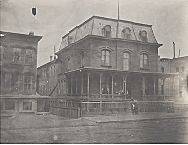| Entries |
| C |
|
Chicago Commons
|

|
Lea Demarest Taylor succeeded her father as director in 1922 and remained in that post until 1954. She adjusted the settlement program to meet the needs of Spanish-speaking neighbors in the 1930s and African Americans in the 1940s and 1950s. Chicago Commons took the lead among Chicago settlements in fighting for adequate relief stipends and job programs during the Great Depression and in promoting racial integration in its neighborhood. But in 1947 the city of Chicago announced plans to build a freeway through that neighborhood, and the settlement merged with Emerson House to become Chicago Commons Association in 1948. The Grand Avenue building was sold and the proceeds used to establish other community centers which sponsored activities but no longer housed residents. The Chicago Commons Association was administering six such centers and three summer camps at the time of Lea Taylor's death in 1975. Since then, Chicago Commons has continued to provide a variety of social services in neighborhoods with few resources.
The Encyclopedia of Chicago © 2004 The Newberry Library. All Rights Reserved. Portions are copyrighted by other institutions and individuals. Additional information on copyright and permissions.